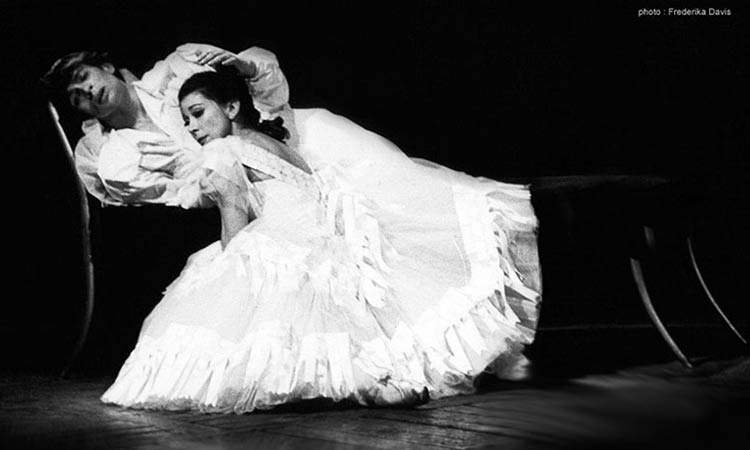
Dame Margot Fontaine ballet dancing with Rudolph Nureyev – Trinity Mirror / Mirrorpix
In 1961, Frederick Ashton attended a performance of “La Dame aux Camélias” by Alexandre Dumas, played by Vivian Leigh and he was inspired to transpose the play into a ballet for his muse Margot Fonteyn. The same year, the young renegade from the Kirov, Rudolf Nureyev, was invited by Margot Fonteyn to take part in a charity gala in London. For his first appearance on stage in England, the dancer asked Ashton to arrange a solo for him… But Nureyev chose the music himself: Scriabin’s Poème Tragique and he arranged a major part of the choreography, which did not fail to annoy Ashton, who was nevertheless bowled over by the young Soviet dancers beauty, technique and culture.
In February 1962, Nureyev was invited to dance “Giselle” for the first time with Margot Fonteyn and following their triumph; he became her main partner, recruited as the permanent guest of the Royal Ballet. Ashton was still thinking about his “Dame aux Camélias”, even more so since he had seen two films that fed his inspiration: “Camille” with Greta Garbo and “L’année dernière à Marienbad” by Alain Resnais. One evening, he heard Liszt’s “Sonata” and immediately the ballet took shape in his mind. Ashton was even more sure of his musical choice when he learned that before her death – at the age of 23! – Marie Duplessis (who became Marguerite Gautier in “La Dame aux Camélias”) had a love affair not only with Alexandre Dumas, but also with Franz Liszt. Naturally, Margot Fonteyn wanted to create the ballet with Rudolf Nureyev. Later on, Nureyev bitterly commented that not a single ballet was created for him alone at the Royal Ballet, but only as Margot Fonteyn’s partner. The first rehearsals were difficult, since Rudolf and Margot were often absent, but Ashton was soon won over by Nureyev’s charisma and by the harmony within the couple and he followed their passionate impulses in his choreography. Ashton also used attitudes and steps borrowed from Nureyev: “There was a sort of animality, a physical intensity and a sexual impulse that charged the atmosphere with electricity”, commented Ashton, for whom Nureyev was the reincarnation of Liszt, the fiery and charming artiste who captivated audiences. In just a fortnight, the ballet was ready. The dress rehearsal was stormy. Nureyev took a pair of scissors and cut off the tails of his costume, which got in the way. But the first gala performance on March 12th 1963 at Covent Garden, in front of the Queen Mother and Princess Margaret, was a huge success and there were twenty-one curtain calls for the dancers and the choreographer.
The ballet – which uses the flashback technique – is divided into five scenes: “Prologue”, “The Meeting”, “In the Countryside”, “The Insult” and “The Death of La Dame aux Camélias”. The stark décor only had one constant element: the bed on which Marguerite Gautier lay dying, re-living her tumultuous affair with Armand. Liszt’s Sonata was arranged by Humphrey Searle, then by Dudley Simpson for a final series of performances in 1977 at the London Coliseum. But in his film entitled, “A Dancer named Nureyev”, filmed in 1973, which includes the whole of “Marguerite and Armand”, the director Louis Jourdan preferred the original version of Liszt’s Sonata for the piano. (The ballet was filmed a second time in 1979 by Patricia Foy for Margot Fonteyn’s television series, “The Magic of Dance”). And yet not a single film can convey the fascination that Fonteyn and Nureyev inspired when they were on stage; the highly charged atmosphere that reigned in the audience and on the set. “Extraordinary actors”, exclaimed Peter Brook, “ who lend depth to every instant, every movement, which suddenly makes the most artificial of all forms become natural and human.” The couple often danced this ballet: roughly forty times at Covent Garden, then at La Scala in Milan, at the Paris Opera for the memorable Centenary Gala for the Figaro on November 17th 1966, in South and North America in 1975 and in London for the last time in 1977.

In March 2000, Sylvie Guillem – one of Nureyev’s favourite dancers, whom he promoted to principal when she was 19 – agreed to dance the ballet with Nicolas Le Riche after declining the offer several times, at the request of Antony Dowell, the Director of the Royal Ballet. Contrary to everyone’s fears, the shadow of Fonteyn and Nureyev did not impair their performance in any way. Sylvie Guillem was stunning, giving a totally different interpretation to Margot Fonteyn and Nicolas Le Riche was excellent; his image was also very different from that of Nureyev. They both danced “Marguerite and Armand” on January 20th 2003 at the prestigious gala performance organised at the Palais Garnier to commemorate the tenth anniversary of Rudolf Nureyev’s death. Other artistes may one day take the risk and dance “Marguerite and Armand”, but no-one will ever be able to watch this ballet without thinking of its immortal creators.
